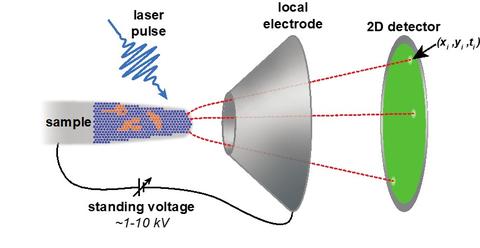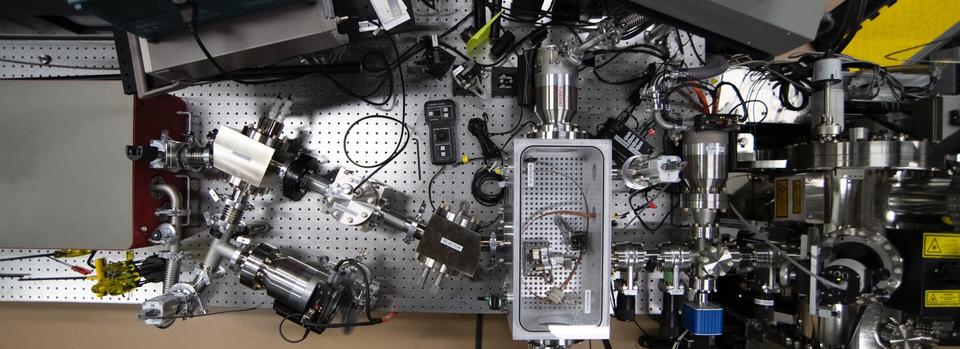Summary
NIST is engaged in a joint effort between the Material Measurement Laboratory (MML) and the Physical Measurement Laboratory (PML) aimed at revolutionizing 3D chemical mapping at the atomic scale by dramatically reducing the uncertainty in measured composition, increasing specimen survivability, and improving the spatial fidelity of 3D reconstructions in atom probe tomography (APT). This is accomplished by replacing the near-ultraviolet laser that is used in commercial instruments with a wavelength-tunable, femtosecond-pulsed coherent extreme ultraviolet light source. The EUV light source is highly absorbed by nearly any material, and its relatively high photon energy may enable additional field ion emission mechanisms.
Description

Sub-nanometer-resolved 3-D chemical mapping of any atom in any solid continues to be an imperative goal of materials research. If reduced to practice, it would have profound scientific, engineering, and economic impacts on U.S. industries collectively worth hundreds of billions of dollars. Such sectors potentially include automotive, aerospace, microelectronics, renewable energy, advanced manufacturing, advanced electronics, nuclear storage, and biomaterials, to name a few. All these diverse, materials-intensive industries depend on microstructural features, elemental composition control, and chemical processes occurring at sub-nanometer dimensions. Thus, for process development, verification and qualification, quality assurance, failure analysis, and competitive engineering, U.S. industry has a very real and pressing need for the development of metrology tools that can provide sub-nanometer-resolved 3-D chemical maps of any elemental isotope in a complex heterogeneous nanostructure with high analytical sensitivity and decreased uncertainty.
Conventional laser-pulsed atom probe tomography (APT) combines a point projection microscope with time of flight (TOF) mass spectroscopy, and operates by means of laser-assisted, thermally triggered field ion evaporation. A high voltage is applied between the specimen and detector and held just below the threshold for ionic field evaporation. A pulsed near ultraviolet (NUV) or deep ultraviolet (DUV) laser imparts a weak thermal transient that triggers field ion evaporation of an atom. This process progressively deconstructs the specimen, ideally one atom at a time. The ions are collected on a 2-D position sensitive detector and isotopically identified by their TOF. 3-D voxel-by-voxel “reconstructions” are then computed using a sequential back projection algorithm. APT can in principle detect chemical concentrations as low as tens of ppm while simultaneously rendering 3-D isotopically identified chemical maps of any element (including hydrogen) with sub-nanometer spatial resolution.
Even though APT is the state-of-the-art for 3D chemical mapping at the nanoscale, it suffers from several fundamental limitations that drastically restrict its performance and utility, can lead to high uncertainty in measured composition, and hinder absolute data quantification. The extreme ultraviolet atom probe tomography (EUV APT) project at NIST aims to address some these limitations by improving on the mechanism of thermal field ion evaporation and replacing the fixed-wavelength, ps-pulsed near or deep ultraviolet laser with a wavelength-tunable, femtosecond-pulsed coherent extreme ultraviolet light source.
Unlike NUV or DUV light, coherent EUV light has potential benefits in atom probe tomography due to the fact that it is highly absorbed by nearly any material of interest. Moreover, the range of available photon energies afforded by EUV are above the ionization potential of any element and work function of any solid. Thus, we avoid the problems encountered in conventional NUV/DUV APT, whereby a complex heterogeneous specimen may have regions with distinctly different photon absorption efficiency and thermal conductivity. EUV offers the possibility of both local heating and direct photoionization pathways to trigger field evaporation.
We have built the world’s first EUV atom probe microscope, and demonstrated for the first time that EUV light can be used to trigger controlled field ion emission from the apex of a needle-shaped specimen as is required to perform APT. We have successfully analyzed a variety of technologically important materials including wide bandgap semiconductors, insulators, and multilayer heterostructures, as well as simple amino acids, organic molecules, and frozen water.
Our ongoing efforts are focused on:
- Understanding the mechanism of EUV-triggered field ion emission.
- Finding unique areas of application of this new technology, especially for materials and heterogeneous nanostructures where conventional NUV/DUV APT fails or does not provide accurate, precise, or easily interpretable results. Some examples of these are: disparate semiconductor/dielectric/metal interfaces, soft and biological materials, insulators, organic molecules, water ice, and halide salts.

Patents
Although patents are issued in the name of the inventor, the rights to inventions resulting from government work belong to the government. NIST's Technology Partnerships Office negotiates licensing of patented NIST technology.
- Norman A. Sanford, Ann Chiaramonti Debay, Brian P. Gorman, David R. Diercks “Hybrid extreme ultraviolet imaging spectrometer,” U.S. Patent Number 9899197; issued February, 2018
- Norman A. Sanford, Ann Chiaramonti Debay, “Imaging spectrometer,” U.S. Patent number 10153144; issued December, 2018
Major Accomplishments
NIST has invented, patented, designed, and built the world’s first extreme ultraviolet atom probe microscope. Since obtaining our first experimental results in the summer of 2018, this work has been presented at over 8 invited and 12 contributed talks at national and international conferences and workshops including APT&M, AVS, CLEO, EMC, IMC, MRS, M&M, OSA FiO, SPIE, and 3D-SSOM. We have published 6 journal articles. In addition, NIST has two patents on EUV APT technology and has commercially licensed one of them. This project is also involved in two Cooperative Research and Development Agreements (CRADAs) with industrial partners.
In 2023 the load lock and sample handling system on our EUV atom probe was modified to accept cryogenically cooled (frozen) samples. This allows work to progress in areas such as examination of organic materials, biomaterials and biomolecules, as well as analysis of inorganic materials with hydrated surfaces or interfaces.

